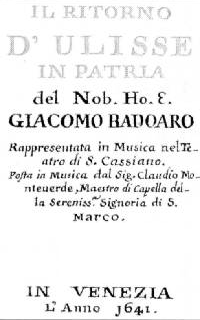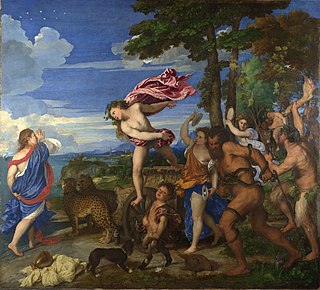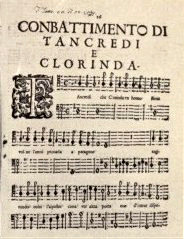
Claudio Giovanni Antonio Monteverdi was an Italian composer, choirmaster and string player. A composer of both secular and sacred music, and a pioneer in the development of opera, he is considered a crucial transitional figure between the Renaissance and Baroque periods of music history.

Torquato Tasso was an Italian poet of the 16th century, known for his 1591 poem Gerusalemme liberata, in which he depicts a highly imaginative version of the combats between Christians and Muslims at the end of the First Crusade, during the Siege of Jerusalem of 1099.

In music, tremolo, or tremolando, is a trembling effect. There are two types of tremolo.

Il ritorno d'Ulisse in patria is an opera consisting of a prologue and five acts, set by Claudio Monteverdi to a libretto by Giacomo Badoaro. The opera was first performed at the Teatro Santi Giovanni e Paolo in Venice during the 1639–1640 carnival season. The story, taken from the second half of Homer's Odyssey, tells how constancy and virtue are ultimately rewarded, treachery and deception overcome. After his long journey home from the Trojan Wars Ulisse, king of Ithaca, finally returns to his kingdom where he finds that a trio of villainous suitors are importuning his faithful queen, Penelope. With the assistance of the gods, his son Telemaco and a staunch friend Eumete, Ulisse vanquishes the suitors and recovers his kingdom.

Jerusalem Delivered, also known as The Liberation of Jerusalem, is an epic poem by the Italian poet Torquato Tasso, first published in 1581, that tells a largely mythified version of the First Crusade in which Christian knights, led by Godfrey of Bouillon, battle Muslims in order to take Jerusalem. Tasso began work on the poem in the mid-1560s. Originally, it bore the title Il Goffredo. It was completed in April, 1575 and that summer the poet read his work to Duke Alfonso of Ferrara and Lucrezia, Duchess of Urbino. A pirate edition of 14 cantos from the poem appeared in Venice in 1580. The first complete editions of Gerusalemme liberata were published in Parma and Ferrara in 1581.
Stile concitato or "agitated style" is a Baroque style developed by Claudio Monteverdi with effects such as having rapid repeated notes and extended trills as symbols of bellicose agitation or anger. Kate Van Orden points out a precedent in Clément Janequin's "La Guerre" (1528). Agathe Sueur points out similarities and ambiguities between Monteverdi's genere concitato and stile concitato in rhetoric and poetry. Examples of stile concitato can be found in these works:
Clorinda or Clorinde may refer to:
The year 1624 in music involved some significant events.

L'Arianna is the lost second opera by Italian composer Claudio Monteverdi. One of the earliest operas in general, it was composed in 1607–1608 and first performed on 28 May 1608, as part of the musical festivities for a royal wedding at the court of Duke Vincenzo Gonzaga in Mantua. All the music is lost apart from the extended recitative known as "Lamento d'Arianna". The libretto, which survives complete, was written in eight scenes by Ottavio Rinuccini, who used Ovid's Heroides and other classical sources to relate the story of Ariadne's abandonment by Theseus on the island of Naxos and her subsequent elevation as bride to the god Bacchus.

Paolo Domenico Finoglia, or Finoglio, was an Italian painter of the early-Baroque period, active mainly in South Italy, including Naples and towns in Apulia.

Clorinda is a fictional character appearing in Torquato Tasso's poem Jerusalem Delivered, first published in 1581. She is a warrior woman of the Saracen army.

Il ballo delle ingrate is a semi-dramatic ballet by the Italian composer Claudio Monteverdi set to a libretto by Ottavio Rinuccini. It was first performed in Mantua on Wednesday, 4 June 1608 as part of the wedding celebrations for Francesco Gonzaga and Margaret of Savoy. Both Vincenzo and Francesco Gonzaga took part in the dancing. Monteverdi also composed the opera L'Arianna and the music for the prologue to Guarini's play L'idropica for the occasion.
Tancredi is an opera by the composer Gioachino Rossini, based on the character in Torquato Tasso's Jerusalem Delivered.
Ensemble Elyma is an early music ensemble specialising in the baroque musical heritage of Latin America, led by Gabriel Garrido.

The Mighty Crusaders is a 1957 film about the First Crusade (1096–1099), based on the 16th-century Italian poem Jerusalem Delivered by Torquato Tasso.

The Italian composer Claudio Monteverdi (1567–1643), in addition to a large output of church music and madrigals, wrote prolifically for the stage. His theatrical works were written between 1604 and 1643 and included operas, of which three—L'Orfeo (1607), Il ritorno d'Ulisse in patria (1640) and L'incoronazione di Poppea (1643)—have survived with their music and librettos intact. In the case of the other seven operas, the music has disappeared almost entirely, although some of the librettos exist. The loss of these works, written during a critical period of early opera history, has been much regretted by commentators and musicologists.
A battaglia is a form of Renaissance and Baroque programme music imitating a battle. The Renaissance form is typically in the form of a madrigal for four or more voices where cannons, fanfares, cries, drum rolls, and other noises of a battle are imitated by voices. The Baroque form is more often an instrumental depiction of a battle.
La Venexiana is an Italian early music ensemble founded and led by Claudio Cavina, an Italian countertenor and conductor.












